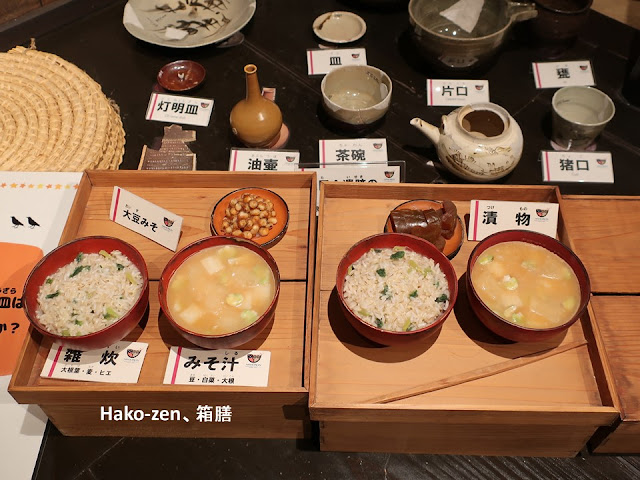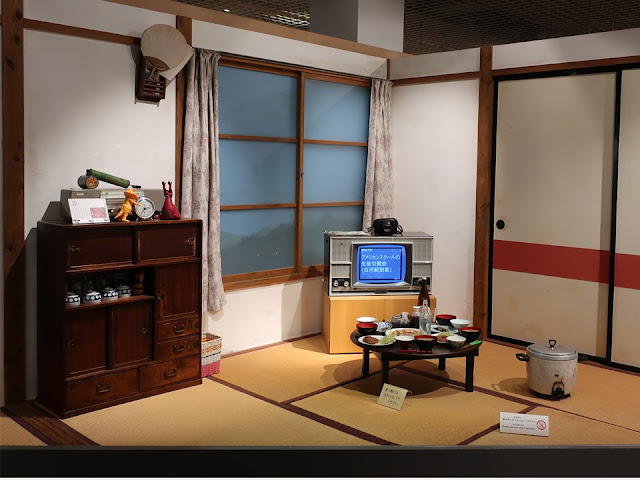It is a huge historical prefectural museum
rather than a cultural property conservation facility. Shirakawa is 180km north
of Tokyo.
The other attractive exhibit is “Showa
period; people’s lives”. Japanese society changed dramatically in the Showa
period (1926-1989). It was inconvenient compared to now, however people made
efforts in order to enjoy lives, I think. It was the vivid time.
Entrance of the permanent exhibition room、常設展示室の入り口
文化財保存施設というよりも、県立の巨大な博物館です。
昭和から旧石器時代までの居間と食事を再現しているのが大きな特徴です。すばらしい! 展示は、新しい時代から古い時代の順でしたが、この記事では逆に説明します。
また、展示室の入口にあった「昭和 人々の暮らし」のパネルに惹かれました。生きる力を感じます。ノスタルジーなのかも知れません。今よりは不便だったけど、工夫して楽しんだという記憶が残っています。
History of kitchens and meals、台所と食事の歴史
The Old Stone Age、旧石器時代
There are remains wherein animal and fish meat were baked on heated stones. Except for utilizing fire, those were feeds of animals, weren’t they?
熱した石の上に、鹿などの獣肉や魚をのせて焼いて食べた跡があるそうです。火を使う以外は、動物としての食事ですね。
Jomon period (more than three thousand
years ago)、縄文時代
Rice farming didn’t start yet, so people hunted or gathered foods.
Fish, meat such as venison and nuts were food ingredients. People used earthenware and cooked. Cookies and dumplings are made. Alcohol was made from wild grapevines.
Furs are put above the fireplace, and nuts are stored in the baskets on the right.
魚、鹿などの獣肉、木の実が食材です。焼くだけでなく、土器で煮たり、クッキーや団子にも作りました。ヤマブドウはお酒の原料にもなったそうです。
いろり?の上には、動物の毛皮もあります。右側の籠には木の実が貯蔵されています。
Earthenware improved cooking; it’s an innovation.
土器ができると料理らしくなってきます。土器の発見は大きなイノベーションだったのですね。
Yayoi period (around two thousand years ago)、弥生時代
Rice farming was introduced from China. Rice has been our staple food since then.
何と言っても米の登場です。
Grilled fishes, wrapped fish or red rice by leaves and liquor made from rice were made.
食卓には、魚や赤米の笹巻き、お米で作ったどぶろくなどが並びます。
Kohun period (from 4th to 7th century)、古墳時代
Rulers emerged; their large tombs are called “Kohun”.
A cooking stove was made inside a house. People could make steamed foods including rice easily.
家の中にカマドができて、蒸す料理も簡単にできるようになりました。お米を「炊く」だけでなく、「蒸し」て食べることもできました。
A pot is set on the stove, and a steamer is put on the pot.
カマドの上に鍋を置いて、その上に蒸し器を置いています。
Steamed rice with nuts, buckwheat's seeds and lotus leaves, steamed bread, soup and liquor of rice are made.
米にクルミや蕎麦の実、ハスの葉を入れた強飯、蒸しパンとスープ、そして米で作ったどぶろくもあります。
Nara and Heian period (710-1185)、奈良平安時代
まだ、竪穴式住居ですね。地面にゴザを敷いた生活です。木で作った曲げ物もありますね。
It is recorded that pickled foods in sake lees or in fermenting mash of soy beans were made in addition to meat, fish and vegetable. Noble class ate bonito fish, abalone and so on. The photo above is meal of ordinary people.
木簡には、肉・魚・野菜に加えて、粕漬けや醤漬(ひしおづけ)の名前もありました。貴族には鰹やアワビなどの高級品が献上されましたが、庶民は写真のような食事でした。
Kamakura and Muromachi period (1185-1573)、鎌倉・室町時代
The power shifted from the noble class to samurai warriors; it is a medieval period.
Soy sauce and miso paste which are basic Japanese seasoning emerged. Stone mills and mortars were excavated in relic sites. People grinded down grains, then made tofu and so on.
Maccha tea outbroke among samurai. Many good meals were developed probably.
醤油や味噌などが登場しました。また、遺跡からは、石臼やすり鉢が発見されます。穀物をすりつぶして利用するようになり、豆腐などが作られていました。また、武士の間では、抹茶が大変流行しました。と書かれていました。この時代になると、美味しい料理がでてきたのでしょうねえ。
The floor material of a living room changed to wood from earth. Irori fireplace emerged. Miso was made in house, but there are no miso balls now; it is an old method.
居間は、土間から板の間になり、囲炉裏が出現しました。みそ玉が吊してありました。煮た大豆を吊して、この後、麹を入れて発酵させます。昔の味噌の作り方です。
Buddhist sutra was written on the stone. Cultured living spread.
石に書いたお経(室町時代)です。初めて見ました。庶民の暮らしも文化的になってきましたね。
Edo period (1603~1868)、江戸時代
It is pre-modern period. People enjoyed lives such as trips and so on.
The big iron pot is set on the stove. Iron wasn’t rare. Kitchenware was improved.
竈には、立派な鉄の釜が載っています。道具が発達しています。
Each family member had their own box which was also used as a small table; it is called “Hako (box) zen (tray)”. The menu was rice, miso-soup and pickled vegetables. However, it says natural ingredients were combined well. We Japanese didn’t eat beef and pork at that time; it was influence of Buddhism. Various tableware were used.
一人一人が自分の箱膳で食事をとります。ご飯と味噌汁、漬物程度ですが、自然の材料を上手く組み合わせた食事だと書かれています。この頃までは、仏教の影響で牛や豚などの獣肉は食べませんでした。食器も多彩になりました。
Around 1970、昭和40年代
We had already used a small round table which is a kind of Western style. Our lifestyle was being westernized; a hamburg-steak, fresh vegetable and beer are on the table.
食卓は西洋の影響を受けたちゃぶ台。みんなで食卓を囲むようになりました。料理は、ハンバーグ、炒め物、焼き魚、味噌汁とご飯、お漬物。そうだったかなあ、キリンラガーは圧倒的なシェアでした。
“Showa period; people’s lives”、昭和/人々の暮らし
The panel at the entrance attracted me so much. It was my childhood.
入ってすぐの、このパネルに惹かれました。まさに、「昭和/人々の暮らし」、私の子供時代です。詳しく紹介します。
Children are running to the forest of the village shrine. It is a playground for children.
鎮守の森と駆けていく子ども達。うーん、そうでしたね。
Girls drew something on the platform for playing. Their eyes are serious.
いやー。何遊びかなあ。子ども達の真剣な目つき。
Toddlers are catching small fishes. I caught medaka fishes; I didn’t eat them of course, but it’s fun time. It’s a natural human instinct, isn’t it?
水路で小魚を探す子ども達。私もメダカを捕りました。食べるわけじゃないけど、捕ることが楽しかった。本能ですね。
What is his target? I couldn’t catch anything using the tool “pachinko”.
何を狙ったか。私は、パチンコで何かをとったためしがなかったです。
Shougi boardgame which is similar to a chess was popular in my hometown Osaka. Adults also played it on the wooden bench at road side in the evening. Wearing yukata (summer kimono) in house wasn’t rare.
将棋で親父には勝てなかった。私が育った大阪では、大人同士の縁台将棋、将棋センターもたくさんありました。
It’s amazing. They shoulder firewood, and walk on the primitive bridge.
木を背負って丸木橋を渡る。すごいなあ。
They might cherish the cow. The woman guides the cow and the man pushes the wooden tool into the ground. There is a cultivator behind them, so it’s changing.
牛に愛着が湧いたでしょうね。後ろには耕運機があり、代替わりの時期です。女性が進路を決めて、男性が鋤いています。
Only few people work together with animals now. They loved their partner animals much more than pets, I think.
今は、動物と一緒に働くことは、ほとんどなくなりました。ペットとは格段に違う愛情があったと思います。
Passengers don’t sit down because of wet seats. It’s a ferry.
立って乗るのですね。濡れるから。
I can say people didn’t drive the car during winter. It's old time.
冬の間は走っていなさそうな車
Tool evolution、暮らしをささえた道具たち
Tools from the ancient period to the pre-modern period are exhibited.
古代から近世までの様々な道具が展示されています。
Not only excavated stones but also reproduced tools which incorporate stones are exhibited. It’s very understandable.
発掘された石器の展示だけではなく、道具として復元して展示しているので、とても分かりやすいです。これで作業するのは大変だとも実感できます。
Replicas of harness which were in the ancient tomb are set on the horse. You can ride on it.
古墳から出土した馬具の複製品を付けた馬の模型に、乗れます。
Iron producing in the Heian period (794-1185); it was hard work.
平安時代の鉄の生産。厳しい仕事でした。
In this museum, I could know the transition of people’s dietary lifestyles well, and I know the lives in the Showa period (1926-1989) in which animal labor force and manual work were major.
It was an inconvenient time, but people enjoyed lives in their own way even in the difficult time. Convenience or material abundance is not directly relevant to enjoyment, I think.
食を中心とした人々の暮らしが分かり、かつ、まだまだ人間の力や動物の力が必要だった昭和の生活が分かりました。不便な時代でしたが、さまざまな楽しみを味わっていたと思います。便利さや物質的な豊かさと楽しみの多寡は、別問題ですね。
The site of "Shirakawa no Seki"、白河の関
It is an ancient checkpoint to the northern Japan.
みちのくの入口、白河関跡です。有名な場所だと思っていたのですが、埋もれていて江戸時代に場所が確定されました。
It is on the quiet mountain road near the pass.
静かな峠道にあります
Visited in November, 2020
Official website: https://www.fcp.or.jp/mahoron/English/index.html
https://www.fcp.or.jp/mahoron/
(in Japanese), accessed in September, 2021
Previous post (museum in the neighboring village):
Ten-ei Culture and Tradition Museum、天栄村ふるさと文化伝承館
Next post (museum
in the neighboring prefecture):






































Comments
Post a Comment